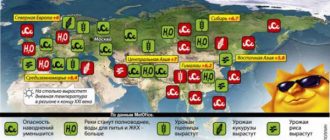Dmitry Tselikov Four more substances were discovered in the atmosphere, that destroy ozone. Are they banned? It’s hard to say … over a new threat looms over the ozone layer: increased erosion chlorofluorocarbons (CFC), and especially the four varieties of which previously not seen in the atmosphere. CFC production was practically completely collapsed in accordance with an international agreement, but in The Montreal Protocol creeped in a reservation, due to which it is unclear then if CFC-113a (one of the newly discovered substances) is prohibited, then whether allowed. Johannes Laube of the University of East Anglia (UK) and colleagues report the discovery of four ozone-depleting substances according to the analysis of air trapped in Greenland snow, and air samples from Tasmania. The essence of the discovery in that CFC-112, CFC-112a, CFC 113a and HCFC-133a were produced in Northern Hemisphere, but it is not known where and by whom.  Photos from open sources Who can’t wait to take the sky from us? (Photo by foureyes.) The biggest concern is the CFC-113a. Volume emissions of this compound are relatively small but fast increases: from 2010 to mid-2012, it has grown more than twice. It is used as a raw material for production. hydrofluorocarbons commonly used as a substitute for CFC in air conditioning systems and some insecticides. All four substances are prohibited by the 1987 Montreal Protocol. However, according to Mr. Laube, there is a reservation about CFC-113a, allowing enterprises to make an exception for them. Ozone the UN Environment Secretariat in 2003 received report on the use of CFC-113a in the production of pesticides, but did not release emission data. Therefore, says Mr. Laube, it is not known: whether this is the result of activity, which permission was obtained, or an indication of illegal production. But one way or another, one thing is clear: emissions are growing rapidly. So far, according to Martin Chipperfield of the University of Leeds (UK), they do not exceed 1% of the indicator, which existed before the Montreal Protocol. “And you must not allow they have become significant, “adds Steve Monzka of the National Ocean and Atmospheric Administration (USA). However, Mr. Laube sounds the alarm anyway. He is convinced that only the top has opened iceberg: “We have not yet determined the volume of emissions, but have already found dozens of unknown ozone-depleting substances and search continues. “The results are published in the journal. Nature Geosciences.
Photos from open sources Who can’t wait to take the sky from us? (Photo by foureyes.) The biggest concern is the CFC-113a. Volume emissions of this compound are relatively small but fast increases: from 2010 to mid-2012, it has grown more than twice. It is used as a raw material for production. hydrofluorocarbons commonly used as a substitute for CFC in air conditioning systems and some insecticides. All four substances are prohibited by the 1987 Montreal Protocol. However, according to Mr. Laube, there is a reservation about CFC-113a, allowing enterprises to make an exception for them. Ozone the UN Environment Secretariat in 2003 received report on the use of CFC-113a in the production of pesticides, but did not release emission data. Therefore, says Mr. Laube, it is not known: whether this is the result of activity, which permission was obtained, or an indication of illegal production. But one way or another, one thing is clear: emissions are growing rapidly. So far, according to Martin Chipperfield of the University of Leeds (UK), they do not exceed 1% of the indicator, which existed before the Montreal Protocol. “And you must not allow they have become significant, “adds Steve Monzka of the National Ocean and Atmospheric Administration (USA). However, Mr. Laube sounds the alarm anyway. He is convinced that only the top has opened iceberg: “We have not yet determined the volume of emissions, but have already found dozens of unknown ozone-depleting substances and search continues. “The results are published in the journal. Nature Geosciences.
Great Britain






